JVC CA-MXS5RMD User Manual
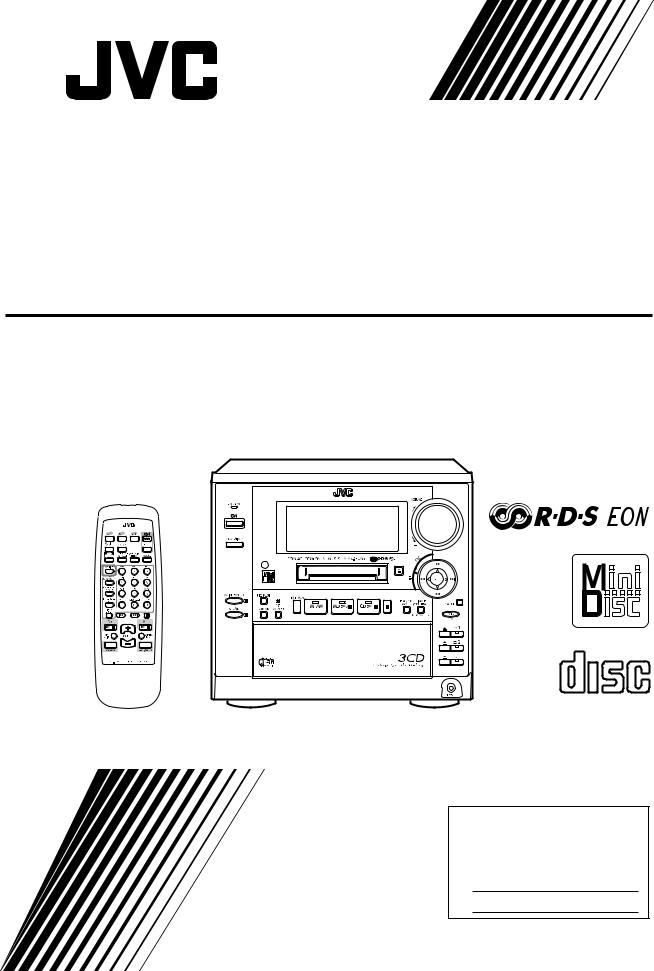
COMPACT COMPONENT MD SYSTEM
CA-MXS5RMD
COMPACT
DIGITAL AUDIO
INSTRUCTIONS
For Customer Use:
Enter below the Model No. and Serial No. which are located either on the rear, bottom or side of the cabinet. Retain this information for future reference.
Model No.
Serial No.
LVT0354-001A [B]
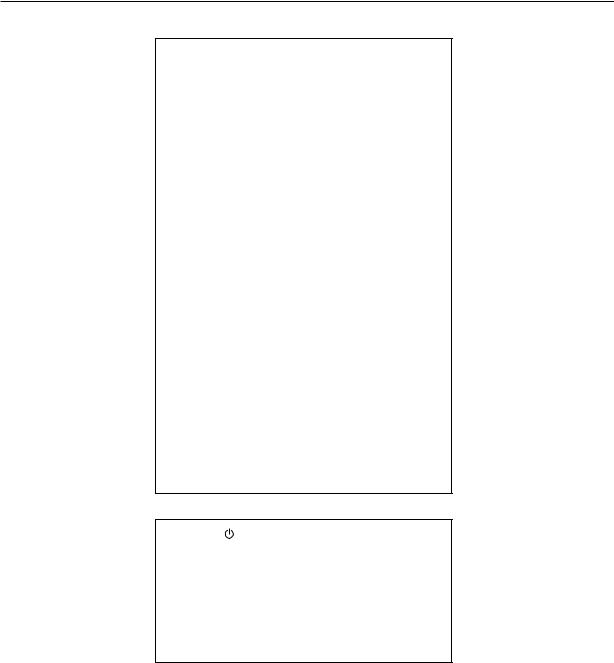
Warnings, Cautions and Others
IMPORTANT for the U.K.
DO NOT cut off the mains plug from this equipment. If the plug fitted is not suitable for the power points in your home or the cable is too short to reach a power point, then obtain an appropriate safety approved extension lead or consult your dealer.
BE SURE to replace the fuse only with an identical approved type, as originally fitted.
If nontheless the mains plug is cut off ensure to remove the fuse and dispose of the plug immediately, to avoid a possible shock hazard by inadvertent connection to the mains supply.
If this product is not supplied fitted with a mains plug then follow the instructions given below:
IMPORTANT:
DO NOT make any connection to the terminal which is marked with the letter E or by the safety earth symbol or coloured green or green-and-yellow.
The wires in the mains lead on this product are coloured in accordance with the following code:
Blue : Neutral Brown : Live
As these colours may not correspond with the coloured markings identifying the terminals in your plug proceed as follows:
The wire which is coloured blue must be connected to the terminal which is marked with the letter N or coloured black.
The wire which is coloured brown must be connected to the terminal which is marked with the letter L or coloured red.
IF IN DOUBT - CONSULT A COMPETENT ELECTRICIAN.
Caution ––  switch!
switch!
Disconnect the mains plug to shut the power off completely (the STANDBY/ON lamp goes off).
The  switch in any position does not disconnect the mains line.
switch in any position does not disconnect the mains line.
•When the unit is on standby, the STANDBY/ON lamp lights red.
•When the unit is turned on, the STANDBY/ON lamp lights green.
The power can be remote controlled.
CAUTION
To reduce the risk of electrical shocks, fire, etc.:
1.Do not remove screws, covers or cabinet.
2.Do not expose this appliance to rain or moisture.
–G-1 –
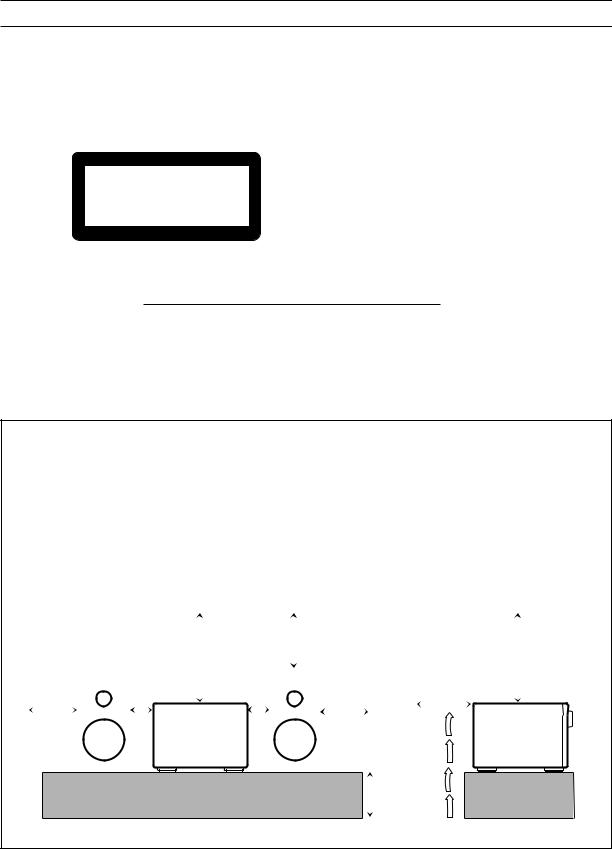
IMPORTANT FOR LASER PRODUCTS
REPRODUCTION OF LABELS
1CLASSIFICATION LABEL, PLACED ON REAR ENCLOSURE
CLASS 1
LASER PRODUCT
2 WARNING LABEL, PLACED INSIDE THE UNIT
DANGER: |
Invisible |
laser |
|
VARNING: Osynlig laser- |
|
ADVARSEL: Usynlig laser- |
|
VARO: Avattaessa ja |
suo- |
||||
radiation |
when open |
and |
|
strålning när denna del är |
|
stråling ved åbning, |
når |
|
jalukitus ohitettaessa |
olet |
|||
interlock failed or defeated. |
|
öppnad och |
spärren |
är |
|
sikkerhedsafbrydere er |
ude |
|
alttiina |
näkymättömälle |
|||
AVOID DIRECT EXPOSURE |
|
urkopplad. |
Betrakta |
ej |
|
af funktion. Undgå udsæt- |
|
lasersäteilylle. Älä katso |
|||||
TO BEAM. |
|
(e) |
|
strålen. |
|
(s) |
|
telse for stråling |
(d) |
|
säteeseen. |
|
(f) |
|
|
|
|
|
|
|
|
|
|
|
|
|
|
1.CLASS 1 LASER PRODUCT
2.DANGER: Invisible laser radiation when open and interlock failed or defeated. Avoid direct exposure to beam.
3.CAUTION: Do not open the top cover. There are no user serviceable parts inside the Unit; leave all servicing to qualified service personnel.
Caution: Proper Ventilation
To avoid risk of electric shock and fire, and to prevent damage, locate the apparatus as follows:
1 Front:
No obstructions and open spacing. 2 Sides/ Top/ Back:
|
|
|
|
|
No obstructions should be placed in the areas shown by |
|
|
|
||||||||||
|
|
|
|
|
the dimensions below. |
|
|
|
||||||||||
|
|
|
|
3 Bottom: |
|
|
|
|
|
|
|
|
|
|
|
|
||
|
|
|
|
|
Place on the level surface. Maintain an adequate air path |
|
|
|
||||||||||
|
|
|
|
|
for ventilation by placing on a stand with a height of 10 cm |
|||||||||||||
|
|
|
|
|
or more. |
|
|
|
|
|
|
|
|
|
|
|
|
|
Front view |
|
|
|
|
|
|
|
|
|
Side view |
||||||||
|
|
|
|
|
|
|
|
|
|
15 cm |
|
|
|
|||||
|
|
|
|
|
|
26 cm |
|
|
|
|
|
|
|
|
|
|
|
26 cm |
15 cm |
|
|
1 cm |
|
1 cm |
|
|
|
|
|
|
|
15 cm |
|
||||
|
|
|
|
|
|
15 cm |
|
|
||||||||||
|
|
|
|
|
|
|
|
|
|
|
|
|||||||
|
|
|
CA-MXS5RMD |
|
|
|
|
|
|
|
CA-MXS5RMD |
|||||||
|
|
|
|
|
|
|
|
|
|
|
|
|
|
|
||||
|
|
|
|
|
|
|
|
|
|
|
|
|
|
|
||||
|
|
|
|
|
|
|
|
|
|
|
|
|
|
10 cm |
|
|
|
|
|
|
|
|
|
|
|
|
|
|
|
|
|
|
|
|
|
||
|
|
|
|
|
|
|
|
|
|
|
|
|
|
|
|
|
||
|
|
|
|
|
|
|
|
|
|
|
|
|
|
|
|
|
||
|
|
|
|
|
|
|
|
|
|
|
|
|
|
|
|
|
|
|
– G-2 –
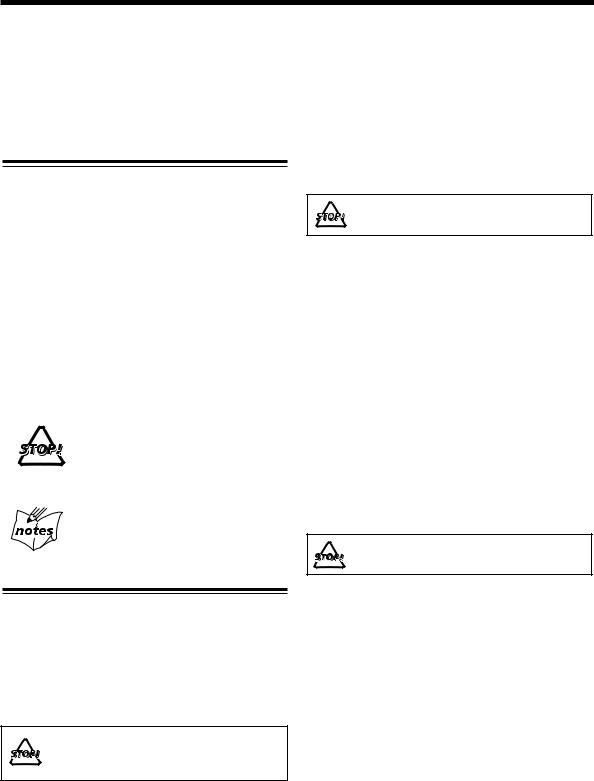
Introduction
We would like to thank you for purchasing one of our JVC products. Before operating this unit, read this manual carefully and thoroughly to obtain the best possible performance from your unit, and retain this manual for future reference.
About This Manual
This manual is organized as follows:
•The manual mainly explains operations using the buttons and controls on the unit. You can also use the buttons on the remote control if they have the same or similar names (or marks) as those on the unit.
If operation using the remote control is different from that using the unit, it is then explained.
•Basic and common information that is the same for many functions is grouped in one place, and is not repeated in each procedure. For instance, we do not repeat the information about turning on/off the unit, setting the volume, changing the sound effects, and others, which are explained in the section “Basic and Common Operations” on pages 14 – 16.
•The following marks are used in this manual:
Gives you warnings and cautions to prevent from damage or risk of fire/electric shock. Furthermore, gives you information which is not good for obtaining the best possible performance from the unit.
Gives you information and hints you had better know.
Precautions
Installation
•Install in a place which is level, dry and neither too hot nor too cold — between 5˚C (41˚F) and 35˚C (95˚F).
•Install the unit in a location with adequate ventilation to prevent internal heat buildup in the unit.
•Leave sufficient distance between the unit and the TV.
•Keep the speakers away from the TV to avoid interference with TV.
DO NOT install the unit in a location near heat sources, or in a place subject to direct sunlight, excessive dust or vibration.
Power sources
• When unplugging the unit from the wall outlet, always pull the plug, not the AC power cord.
DO NOT handle the AC power cord with wet hands.
Moisture condensation
Moisture may condense on the lens inside the unit in the following cases:
•After starting heating in the room
•In a damp room
•If the unit is brought directly from a cold to a warm place
Should this occur, the unit may malfunction. In this case, leave the unit turned on for a few hours until the moisture evaporates, unplug the AC power cord, then plug it in again.
Others
•Should any metallic object or liquid fall into the unit, unplug the unit and consult your dealer before operating any further.
•If you are not going to operate the unit for an extended period of time, unplug the AC power cord from the wall outlet.
DO NOT disassemble the unit since there are no user serviceable parts inside.
If anything goes wrong, unplug the AC power cord and consult your dealer.
– 1 –

Contents
Location of the Buttons and Controls ........... |
3 |
Front Panel ............................................................. |
4 |
Remote Control ...................................................... |
5 |
Getting Started................................................ |
6 |
Unpacking .............................................................. |
6 |
Connecting Antennas ............................................. |
6 |
Connecting Speakers .............................................. |
7 |
Connecting Other Equipment ................................ |
8 |
Putting the Batteries into the Remote Control ....... |
9 |
Basic Settings ................................................ |
10 |
Turning On the Power .......................................... |
11 |
Setting the Clock .................................................. |
11 |
Changing the Main Display Screen ..................... |
12 |
Changing the display Brightness and Contrast .... |
13 |
Basic and Common Operations ................... |
14 |
Selecting the Sources and Starting Play .............. |
15 |
Adjusting the Volume ........................................... |
15 |
Reinforcing the Bass Sound ................................. |
15 |
Selecting the Sound Modes .................................. |
16 |
Creating Your Own Sound Mode |
|
— MANUAL Mode ...................................... |
16 |
Listening to FM and AM (MW/LW) |
|
Broadcasts ..................................................... |
17 |
Tuning in a Station ............................................... |
18 |
Presetting Stations ................................................ |
18 |
Tuning in a Preset Station .................................... |
19 |
Receiving FM Stations with RDS ........................ |
19 |
Changing the RDS Information ........................... |
20 |
Searching for Programs by PTY Codes |
|
(PTY Search) ................................................. |
20 |
Switching to a Program Type of Your Choice |
|
Temporarily ................................................... |
21 |
Playing Back CDs ......................................... |
24 |
Loading CDs ........................................................ |
25 |
Playing Back the Entire Discs |
|
— Continuous Play ........................................ |
25 |
Basic CD Operations ........................................... |
25 |
Programing the Playing Order of the Tracks |
|
— Program Play ............................................ |
26 |
Playing at Random — Random Play ................... |
27 |
Repeating Tracks or CDs — Repeat Play ............ |
27 |
Playing Back an MD ..................................... |
28 |
Playing Back the Entire MD — Normal Play ...... |
29 |
Basic MD Operations ........................................... |
29 |
Programing the Playing Order of the Tracks — |
|
Program Play ................................................. |
30 |
Playing at Random — Random Play ................... |
31 |
Repeating Tracks — Repeat Play ........................ |
31 |
Prohibiting Disc Ejection — Disc Lock .............. |
31 |
Recording on MDs ........................................ |
32 |
Before You Start Recording ................................. |
33 |
Recording Any Sound Source |
|
— Standard Recording .................................. |
34 |
Recording CDs ..................................................... |
35 |
Recording FM/AM (LW/MW) Broadcasts |
|
— Monaural Recording and Stereo |
|
Recording ...................................................... |
36 |
Recording the External Equipment |
|
— Sound Synchronized Recording and Stereo |
|
Recording ...................................................... |
36 |
Editing MDs .................................................. |
38 |
Introducing MD Editing Functions ...................... |
39 |
DIVIDE Function ................................................ |
40 |
JOIN Function ...................................................... |
41 |
MOVE Function ................................................... |
41 |
ERASE Function .................................................. |
42 |
ALL ERASE Function ......................................... |
43 |
Making Your Own Titles and Screens......... |
44 |
Assigning Titles to an MD ................................... |
45 |
CreatingYour Own Opening and Ending Screens ..... |
49 |
Using the Timers ........................................... |
50 |
Using Recording Timer ........................................ |
51 |
Using Daily Timer ............................................... |
52 |
Using Sleep Timer ............................................... |
54 |
Timer Priority ....................................................... |
54 |
Maintenance .................................................. |
55 |
Additional Information ................................ |
56 |
MD Disc Types .................................................... |
56 |
ATRAC (Adaptive TRansform Acoustic Coding) |
.. 56 |
UTOC (User Table Of Contents) ......................... |
56 |
SCMS (Serial Copy Management System) .......... |
56 |
Sound Skip Guard Memory ................................. |
57 |
MD Messages ................................................ |
58 |
Troubleshooting ............................................ |
59 |
Specifications ................................................. |
60 |
– 2 –
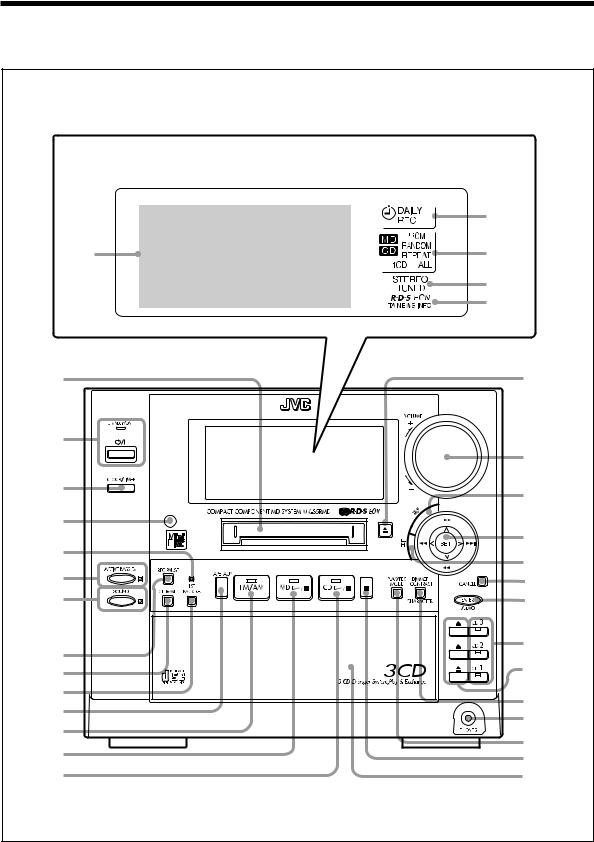
Location of the Buttons and Controls
Become familiar with the buttons and controls on your unit.
Front Panel |
|
|
Display Window |
|
|
|
/ |
|
l |
z |
|
|
x |
|
|
c |
|
1 |
t |
|
2 |
|
|
|
y |
|
3 |
u |
|
|
||
4 |
|
|
|
i |
|
5 |
o |
|
|
||
6 |
; |
|
|
||
7 |
a |
|
8 |
s |
|
|
||
9 |
d |
|
|
||
p |
f |
|
q |
||
g |
||
w |
||
|
||
e |
h |
|
j |
||
|
||
r |
k |
|
|
– 3 – |

Continued 
See pages in the parentheses for details.
Front Panel
1 MD loading slot
2  (Standby/On) button and STANDBY/ON lamp
(Standby/On) button and STANDBY/ON lamp
(11)
3 CLOCK/TIMER button (11, 51)
4 Remote sensor
5 Recording lamp (34)
6 ACTIVE BASS EX. (extension) button and lamp (15)
7 SOUND button and lamp (16)
8 REC PAUSE button (34)
9 CD 3MD button (35)
p 1ST TRACK REC button (35)
qTAPE/AUX button (15, 34)
•Pressing this button also turns on the unit. w FM/AM button and lamp (15, 18)
•Pressing this button also turns on the unit.
e MD #/ 8 (play/pause) button and lamp (15, 29)
•Pressing this button also turns on the unit.
r CD #/ 8 (play/pause) button and lamp (15, 25)
•Pressing this button also turns on the unit. t MD 0(eject) button (29)
•Pressing this button also turns on the unit. y VOLUME control (15)
u TITLE button (45, 49) i Joy control
•1  / ¡
/ ¡ / 4
/ 4  / ¢
/ ¢ , and SET
, and SET
Pressing SET also turns on the unit.
o EDIT button (40)
; CANCEL button (11, 27, 30, 40, 46) a ENTER/DEMO button (12, 40, 46) s Disc number buttons and lamps (25)
• CD 1, CD 2, and CD 3
Pressing one of these buttons also turns on the unit.
dCD 0(open/close) buttons (25)
• Pressing one of these buttons also turns on the unit.
f DIMMER/CONTRAST button (13) CHARACTER button (45)
g PHONES jack (15)
h PLAY/REC MODE button (26, 30, 36, 37) j 7(stop) button (25, 29, 34)
k Disc trays (25)
Display window l Main display
•Shows the source name, track number, and other information.
/Timer mode indicators
• , DAILY (Daily Timer) and REC (Recording
, DAILY (Daily Timer) and REC (Recording
Timer)
zMD/CD play mode indicators
• MD, CD, PRGM (Program), RANDOM, and
REPEAT (1/CD/ALL)
xTuner mode indicators
•STEREO and TUNED c RDS operation indicators
•RDS, EON, and TA/NEWS/INFO
When using the remote control, point it at the remote sensor on the front panel.
About the indications in the main display
When using some functions with the remote control, the indications in the main display appear differently at first from those when using the same functions with the buttons on the unit.
Ex. When selecting a CD track using the remote control
This indication does not appear when using the buttons on the unit except the TAPE/AUX, FM/AM, MD # / 8, CD # / 8, TITLE, and EDIT buttons.
– 4 –
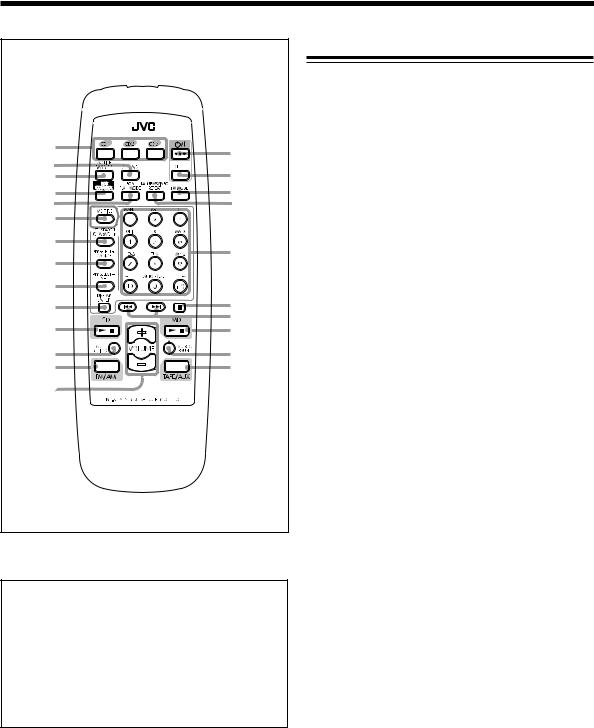
Remote Control
1 |
t |
|
2 |
||
y |
||
3 |
||
4 |
u |
|
5 |
i |
|
6 |
|
|
7 |
o |
|
8 |
||
|
||
9 |
|
|
p |
; |
|
q |
a |
|
s |
||
w |
d |
|
e |
f |
r
*When using the remote control:
For RDS operations, press RDS CONTROL on the remote control first when using the buttons (5, 7, 8, 9, p and i).
For entering MD titles, press MD TITLE on the remote control first when using the buttons (7, 8, 9, p, o).
•After entering titles, make sure to change the operation mode of the remote control to the one you want to use by pressing CD 3/ 8(q), FM/AM (e), MD 3/ 8(s), or TAPE/AUX (f).
Remote Control
1 Disc number buttons (25)
• CD 1, CD 2, and CD 3
Pressing one of these buttons also turns on the unit.
2 SOUND button (16)
3 ACTIVE BASS EX. (extension) button (15)
4 RDS CONTROL button (20)
5* PLAY MODE button (26, 30) EON button (21)
6 MD TITLE button (47)
7* CHARACTER button (48) PTY SEARCH button (20)
8* CANCEL button (27, 30, 48) PTY SELECT + button (20)
9* SET button (48)
PTY SELECT – button (20) p* ENTER button (48)
DISPLAY button (20)
qCD 3/ 8(play/pause) button (15, 25)
•Pressing this button also turns on the unit. w FADE MUTING button (15)
e FM/AM button (15, 18)
•Pressing this button also turns on the unit. r VOLUME + / –button (15)
t  (Standby/On) button (11) y SLEEP button (54)
(Standby/On) button (11) y SLEEP button (54)
u FM MODE button (18) i* REPEAT button (27, 31)
TA/NEWS/INFO button (21) o* Number buttons
•1 – 10, +10 buttons (19, 26, 29)
•Character entry buttons (A – Z, 0 – 9) (48)
•ø/ Øbuttons (48)
•AUTO PRESET button (18)
; 7(stop) button (25, 29, 34)
a4/ ¢(reverse search/forward search) button (18, 26, 27, 29)
sMD 3/ 8(play/pause) button (15, 29)
•Pressing this button also turns on the unit. d MD REC PAUSE button (34)
f TAPE/AUX button (15, 34)
•Pressing this button also turns on the unit.
– 5 –
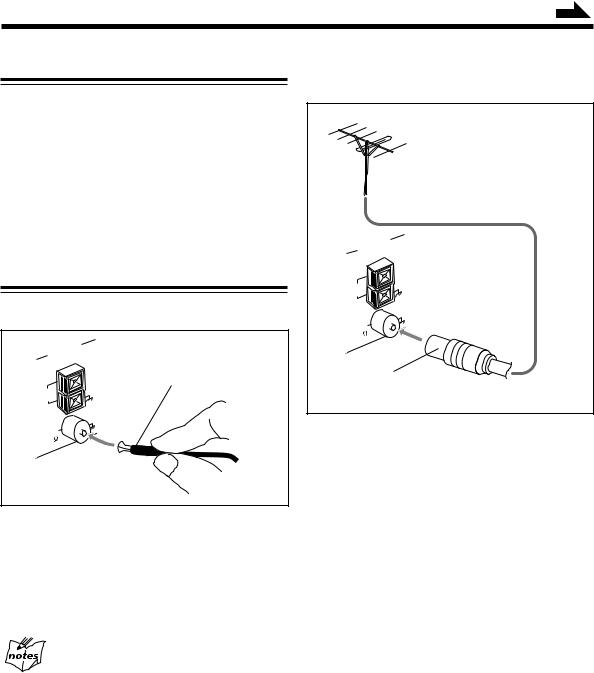
Getting Started
Continued
Unpacking
After unpacking, check to be sure that you have all the following items.
The number in the parentheses indicates the quantity of the pieces supplied.
•AM loop antenna (1)
•FM antenna (1)
•Remote control (1)
•Batteries (2)
If any is missing, consult your dealer immediately.
Connecting Antennas
FM antenna
|
ANTENNA |
|
|||
|
|
|
|
AM |
FM antenna (supplied) |
|
|
|
|
EXT |
|
|
|
|
|
|
|
AM |
|
|
|
||
LO |
OP |
|
|
|
|
|
|
|
|
|
|
|
|
FM |
) |
|
|
(75 |
|
||||
|
L |
|
|||
CO |
AXIA |
|
|||
|
|
||||
|
|
|
|
||
To connect an outdoor FM antenna
Before connecting it, disconnect the supplied FM antenna.
Outdoor FM antenna (not supplied)
|
ANTENNA |
|
||
|
|
|
AM |
|
|
|
|
EX |
T |
AM |
|
|
||
LO |
OP |
|
|
|
|
|
|
|
|
|
|
FM |
) |
|
(75 |
|
|||
|
|
|||
CO |
AXIAL |
|
||
|
|
|
||
A 75Ω antenna with coaxial type connector (DIN 45325) should be used.
1 Attach the FM antenna to the FM (75 Ω) COAXIAL terminal.
2 Extend the FM antenna.
3 Fasten it up in the position which gives you the best reception.
About the supplied FM antenna
The FM antenna supplied with this unit can be used as temporary measure. If reception is poor, you can connect an outdoor FM antenna.
– 6 –

AM antenna |
Connecting Speakers |
|
|
1 |
2 |
3 |
|
|
Vinyl-covered |
|
|
wire |
|
|
(not supplied) |
|
AM loop antenna |
|
|
(supplied) |
|
1 Connect the AM loop antenna to the AM LOOP terminals as illustrated.
2 Turn the AM loop antenna until you have the best reception.
To connect an outdoor AM antenna
When reception is poor, connect a single vinyl-covered wire to the AM EXT terminal and extend it horizontally. (The AM loop antenna must remain connected.)
For better reception of both FM and AM (MW/LW)
•Make sure the antenna conductors do not touch any other terminals and connecting cords.
•Keep the antennas away from metallic parts of the unit, connecting cords, and the AC power cord.
You can connect the speakers using the speaker cords.
1 |
2 |
3, 4 |
Red |
|
|
|
Black |
|
|
Speaker cord |
|
Right |
|
Left |
speaker |
|
speaker |
1 Twist the core of the cord at the end of each cord, then remove the insulation.
2 Open the speaker terminal.
3 Insert the end of the speaker cord to the terminal.
Match the polarity of the speaker terminals: Red (+) to red (+) and black (–) to black (–).
4 Close the speaker terminal on the rear of the unit.
Use only speakers with the same speaker impedance as indicated by the speaker terminals on the rear of the unit.
– 7 –

Continued
Connecting Other Equipment
You can connect the following equipment to this unit:
•Cassette deck — used as a playback and recording device. By using the cassette deck, you can record any source played back on this unit.
•Audio equipment with an optical digital output terminal
— used only as a digital playback device.
When you connect and use these equipment, refer also to the manuals supplied with them.
Be sure that the plugs of the audio cords and the jacks on the rear of the unit are color coded: White plugs and jacks are for left audio signals, and red ones for right audio signals.
• DO NOT connect other equipment while the power is on.
• DO NOT plug in any equipment until all connections are complete.
To connect a cassette deck
To input (REC) |
Cassette deck |
To output (PLAY) |
By using audio cords (not supplied), connect:
•Between the audio input jacks on the cassette deck and the TAPE OUT (REC) jacks — For recording on the cassette deck.
•Between the audio output jacks on the cassette deck and the TAPE IN (PLAY) jacks — For playing a tape.
To connect audio equipment with an optical digital output terminal
Protective cap
Before connecting the other equipment, remove the protective cap from the terminal.
Audio equipment with an
optical digital output
To optical digital output
Connect between the optical digital output terminal on the other equipment and the AUX terminal.
– 8 –
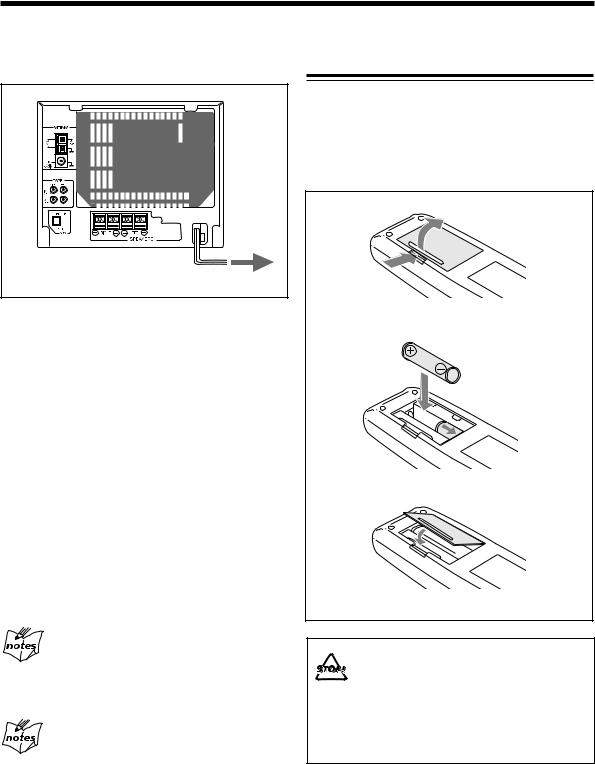
NOW, you can plug in the unit and other connected equipment FINALLY!
To a wall outlet
When connecting the AC power cord into a wall outlet, the unit automatically starts display demonstration.
• Pressing TITLE on the unit while the unit is turned on, shows the title entry screen (if there is no MD in the MD loading slot). You can experience how to select a character on this screen.
To stop and cancel the display demonstration, press ENTER/DEMO during display demonstration. “MODE OFF!” appears in the main display, the unit is turned off, then the display dims and “POWER SAVING” appears in the dimmed main display.
After canceling the display demonstration, it will start only when the AC power cord is reconnected or when a power failure is recovered.
• Pressing any button on the unit or the remote control stops the demonstration temporarily.
To start the display demonstration manually
See “Changing the Main Display Screen” on page 12.
Putting the Batteries into the Remote Control
Insert the batteries — R6P(SUM-3)/AA(15F) — into the remote control, by matching the polarity (+ and –) on the batteries with the + and – markings on the battery compartment.
When the remote control can no longer operate the unit, replace both batteries at the same time.
1
2
R6P(SUM-3)/AA(15F)
3
If you do not cancel the display demonstration, it will start automatically in the following cases
•2 minutes after the unit is turned off.
•When no operation is done for more than 2 minutes after the unit is turned on.
If you do not want to start the display demonstration
when the AC power cord is reconnected or when a power failure is recovered
See “To store the selected main display screen in backup memory” on page 13.
•DO NOT use an old battery together with a new one.
•DO NOT use different types of batteries together.
•DO NOT expose batteries to heat or flame.
•DO NOT leave the batteries in the battery compartment when you are not going to use the remote control for an extended period of time. Otherwise, it will be damaged from battery leakage.
– 9 –

Basic Settings
Continued 
The buttons and controls enlarged in the illustration below are used and explained in this section (pages 11 to 13).
Front panel |
Remote control |
– 10 – |
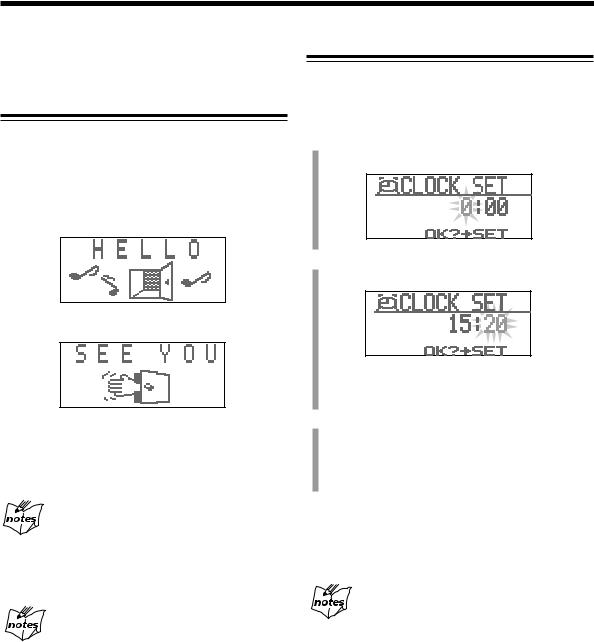
Before operating the unit any further, first set the clock built in this unit, then some other basic settings.
Turning On the Power
When you press the play button (#/8) for a particular source or the source selecting buttons such as FM/AM and TAPE/AUX, the unit automatically turns on (and starts playback if the source is ready).
• Pressing SET on the unit also turns on the unit.
To turn on the unit without playing, press  so that the STANDBY/ON lamp on the unit lights green.
so that the STANDBY/ON lamp on the unit lights green.
To turn off the unit (on standby), press  again so that the STANDBY/ON lamp lights red.
again so that the STANDBY/ON lamp lights red.
A little power is always consumed even while the unit is in standby mode.
To switch off the power supply completely, unplug the AC power cord from the AC outlet.
You can change the opening or ending screen
illustrated above
Instead of showing the above opening or ending screen, you can make your original screens. To make and store your original screens, see “Creating Your Own Opening and Ending Screens” on page 49.
When you unplug the AC power cord or if a power
failure occurs
The clock is reset to “0:00” right away, while the tuner preset stations and other settings will be erased in a few days.
Setting the Clock
You can set the clock whether the unit is turned on or in standby mode.
On the unit ONLY:
1 Press CLOCK/TIMER.
The hour digit in the main display starts flashing.
2 Push and hold the joy control rightward (¢  ) or leftward (4
) or leftward (4  ) to adjust the hour, then press SET.
) to adjust the hour, then press SET.
• If you want to correct the hour after pressing SET, press CANCEL. The hour digit starts flashing again.
3 Push and hold the joy control rightward (¢  ) or leftward (4
) or leftward (4  ) to adjust the minute, then press
) to adjust the minute, then press
SET.
“ADJUST OK!” appears in the main display, and the built-in clock starts.
To adjust the clock again
Once you have adjusted the clock, you need to press CLOCK/TIMER repeatedly until the CLOCK SET screen appears in the main display (the hour digit starts flashing).
If there is a power failure
The clock loses the setting and is reset to “0:00.” You need to set the clock again.
– 11 –
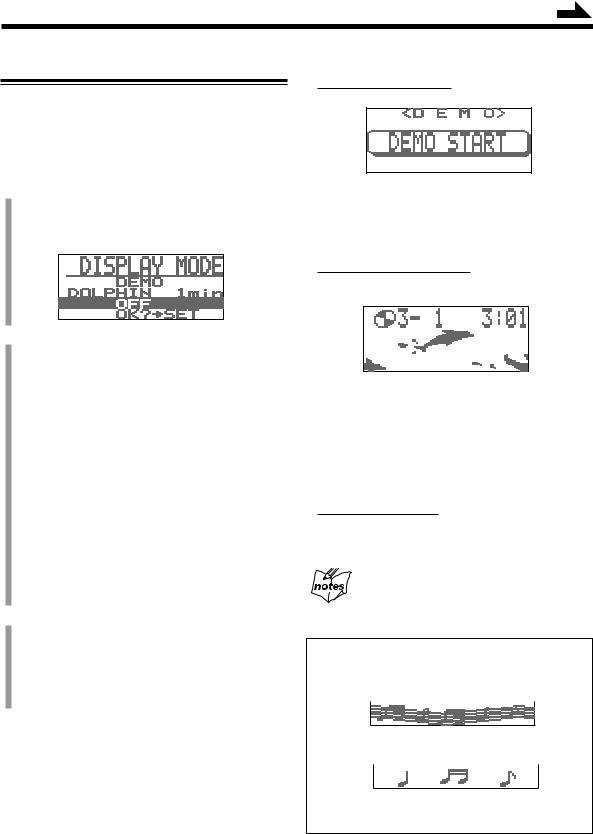
Continued
Changing the Main Display Screen
You can change the screen pattern which appears in the main display.
On the unit ONLY:
You can do the following procedure while the unit is turned on or in standby mode.
1 Press ENTER/DEMO.
The DISPLAY MODE screen appears.
• If “MODE OFF” appears, press ENTER/DEMO again.
2 Push the joy control upward (¡  ) or downward (1
) or downward (1  ) to select the screen pattern you want.
) to select the screen pattern you want.
DEMO: To show the display demonstration in the main display.
When the AC power is unplugged, this setting is automatically restored unless you have stored another setting in backup memory. See “To store the selected main display screen in backup memory” on page 13.
DOLPHIN: To make dolphins swim in the main display. You can also select the startingtime (no operation period) when to start the dolphin screen.
OFF: To cancel the display demonstration and the dolphin screen.
3 When selecting “DOLPHIN” in the above step: Push the joy control repeatedly rightward (¢  ) or leftward (4
) or leftward (4  ) to select the starting-time (no operation period).
) to select the starting-time (no operation period).
• You can select the starting-time from among 1, 3, and 5 minutes.
4 Press SET to finish the setting.
How these settings work
•When selecting “DEMO”:
Display demonstration starts.
If you do not cancel the display demonstration by pressing ENTER/DEMO, display demonstration automatically starts in the following cases:
–2 minutes after the unit is turned off.
–When no operation is done for more than 2 minutes.
•When selecting “DOLPHIN”:
–If the unit is turned on:Dolphins start swimming in the lower portion of the main display.
If you press any button while dolphins are swimming in the main display, normal screen (see illustration below) resumes. However, dolphin starts swimming again if no operation is done for your specified starting-time (1, 3 and 5 minutes).
– If the unit is turned off (on standby):“DOLPHIN ON!” appears in the main display, and the unit is turned off again.
•When selecting “OFF”:
Both display demonstration and dolphin screen are canceled, and one of the following screens (normal screens) appears in the lower portion of the main display.
While recording or editing an MD
Display demonstration and dolphin screen will not appear.
Normal screens
Playback screen: while playing any source or receiving a station
Stop screen: while pausing or receiving no station:
• If the source is “TAPE” or “AUX DIGIT.,” only the playback screen will appear.
– 12 –
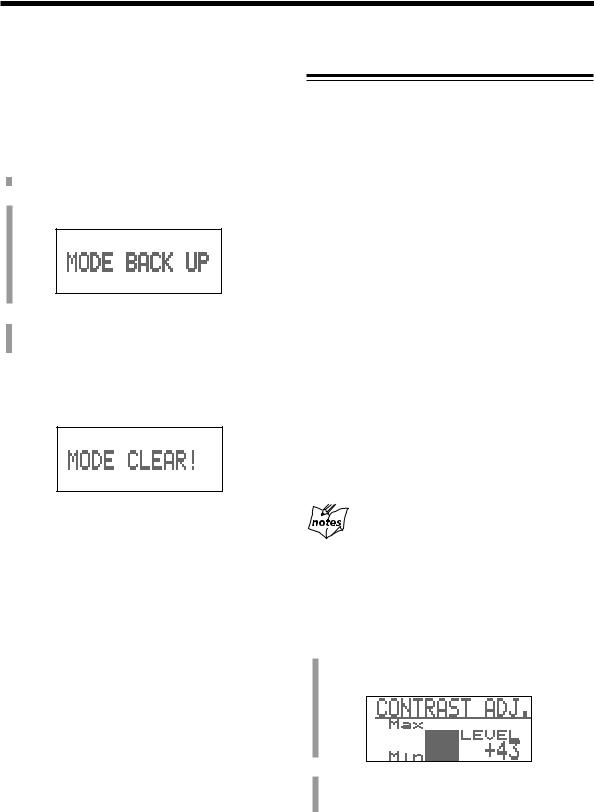
To store the selected main display screen in backup memory
You can store the selected main display screen in back up memory. So, even though the AC power is unplugged or a power failure occurs, the setting is kept in memory and will not be reset to the display demonstration.
On the unit ONLY:
1 Unplug the AC power cord.
2 Plug the AC power cord again while holding 7and
ENTER/DEMO at the same time.
3 Select the main display screen setting (DEMO, DOLPHIN, or OFF) by following steps 1 to 4 on page 12.
To erase backup memory
Repeat steps 1 and 2 of the above procedure.
Backup memory is cleared.
• When the AC power plug is reconnected or a power failure is recovered, display demonstration automatically starts.
Changing the Display Brightness and
Contrast
To change the brightness
You can change the display brightness whether the unit is turned on or in standby mode.
You can set and memorize the display brightness setting each for power-on time and for power-off (standby) time.
On the unit ONLY:
Press DIMMER/CONTRAST.
Each time you press the button, the display brightness changes as follows:
• When the unit is turned off (on standby):
Dark (POWER SAVING mode*) +=Dimmer**
• When the unit is turned on: Bright +=Dimmer***
*During POWER SAVING mode:
•Much less electric power (1.6 watt) is consumed. If not selected, 14 watts of electric power are consumed even while the unit is turned off (on standby).
•“POWER SAVING” appears in the main display.
•You cannot insert an MD in the MD loading slot. To insert an MD, turn on the unit first.
**You can turn on the unit by inserting an MD in the MD loading slot.
***When using some functions, the display window brightens for a while. For examples, when selecting the source either using the buttons on the unit or on the remote control, selecting the CD or MD track using the buttons on the remote control, etc.
During display demonstration
The display always brightens regardless of the dimmer setting.
To change the contrast
You can change the display contrast only when the unit is turned on.
On the unit ONLY:
1 Press and hold DIMMER/CONTRAST for more than 2 seconds.
The CONTRAST ADJ. screen appears.
2 Push and hold the joy control upward (¡  ) or downward (1
) or downward (1  ) to adjust the contrast.
) to adjust the contrast.
• You adjust the contrast within the range of 0 to +64.
3 Press SET to finish the adjustment.
– 13 –
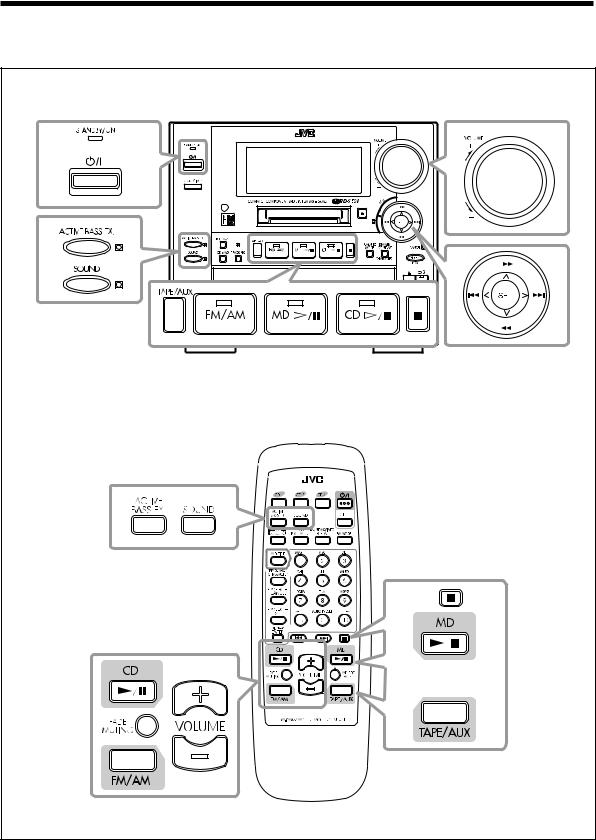
Basic and Common Operations
Continued 
The buttons and controls enlarged in the illustration below are used and explained in this section (pages 15 to 16).
Front panel |
Remote control |
– 14 – |
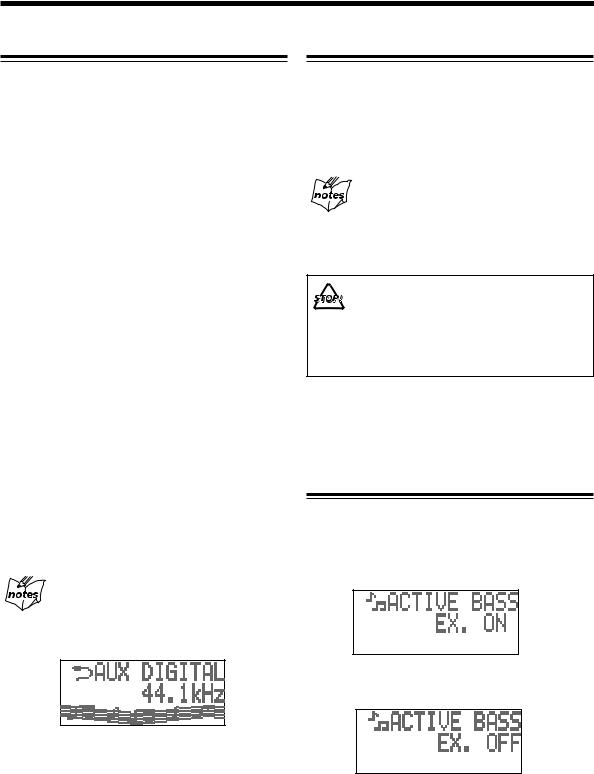
Selecting the Sources and Starting Play
To select the tuner as the source, press FM/AM. The unit automatically turns on, the lamp on the FM/AM button lights, and the last received station is tuned in.
• For more detailed operations, see pages 17 to 23.
To select the CD player as the source, press CD #/8. The unit automatically turns on, and the lamp on the
CD #/8 button lights. (Play starts if a CD is on one of the CD trays.)
To stop play, press 7.
• For more detailed operations, see pages 24 to 27.
To select the MD player as the source, press MD #/8. The unit automatically turns on and the lamp on the
MD #/8 button lights. (Play starts if an MD is in the MD loading slot).
To stop play, press 7.
• For more detailed operations, see pages 28 to 31.
To select the external equipment as the source, press TAPE/AUX. The unit automatically turns on.
•Each time you press the button, the source alternate between “TAPE” and “AUX DIGIT.”
TAPE: To use the equipment connected to the TAPE jacks.
When selecting “TAPE,” the sound input level appears for a while. (See page 34 for the sound input level.)
AUX DIGIT. (DIGITAL): To use the digital equipment connected to the AUX terminal.
•For operating the external equipment, see the manuals supplied with them.
While selecting the digital equipment (“AUX
DIGITAL”) as the source
The sampling frequency of the connected digital equipment is shown in the main display. (If no equipment is connected to the AUX terminal, “UNLOCK” appears.)
Ex. When the sampling frequency is 44.1 kHz
Adjusting the Volume
You can adjust the volume level only while the unit is turned on.
Turn VOLUME clockwise to increase the volume or counterclockwise to decrease it.
When using the remote control, press VOLUME + to increase the volume or press VOLUME – to decrease it.
For private listening
Connect a pair of headphones to the PHONES jack. No sound comes out of the speakers. Be sure to turn down the volume before connecting or putting on the headphones.
DO NOT turn off (on standby) the unit with the volume set to an extremely high level; otherwise, the sudden blast of sound can damage your hearing, speakers and/or headphones when you turn on the unit or start playing any source.
REMEMBER you cannot adjust the volume level while the unit is in standby mode.
To turn down the volume level temporarily
Press FADE MUTING on the remote control. To restore the sound, press the button again.
Reinforcing the Bass Sound
The richness and fullness of the bass sound is maintained regardless of how low you set the volume.
You can use this effect only for playback.
To get the effect, press ACTIVE BASS EX. (extension) so that the ACTIVE BASS EX. on the unit lamp lights up.
To cancel the effect, press the button again so that the lamp goes off.
– 15 –
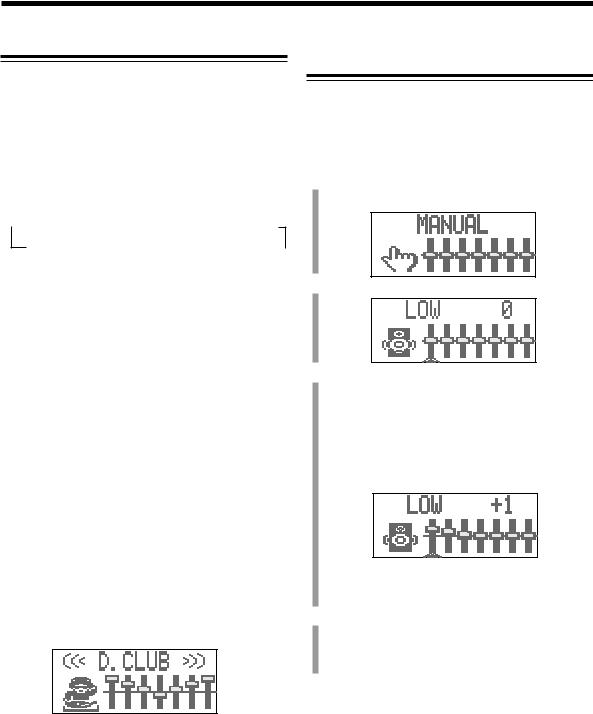
Selecting the Sound Modes
You can select one of the 6 preset sound modes (3 surround modes and 3 SEA – Sound Effect Amplifier – modes) and 1 manual mode. The sound modes can be applied only to playback sounds, and cannot be used for recording.
To select the sound modes, press SOUND until the sound mode you want appears on the display. The SOUND lamp also lights.
• Each time you press the button, the sound modes change as follows:
 D.CLUB
D.CLUB  HALL
HALL STADIUM
STADIUM ROCK
ROCK
FLAT MANUAL
MANUAL CLASSIC
CLASSIC POP
POP
(Canceled)
Surround modes *:
D. (Dance) CLUB: Increases resonance and bass. HALL: Adds depth and brilliance to the
sound.
STADIUM: Adds clarity and spreads the sound, like in an outdoor stadium.
Creating Your Own Sound Mode —
MANUAL Mode
You can create and store your own sound mode.
• There is a time limit in doing the following steps. If the setting is canceled before you finish, start from step 1 again.
On the unit ONLY:
1 Press SOUND repeatedly until “MANUAL” appears in the main display.
2 Press SET.
SEA modes:
ROCK: Boosts low and high frequency. Good for acoustic music.
POP: Good for vocal music. CLASSIC: Good for classical music.
Manual mode:
MANUAL: Your individual mode stored in memory. See “Creating Your Own Sound Mode — MANUAL Mode.”
FLAT: Cancels the sound mode.
*Surround elements are added to the sound modes to create a being-there feeling in your room.
To check the sound mode currently selected, press SOUND once while the SOUND lamp on the unit is lit. The currently selected sound mode screen will appear in the main display.
Ex. when “D.CLUB” is currently selected.
3 Adjust the equalizer pattern.
1)Push the joy control rightward (¢  ) or leftward (4
) or leftward (4  ) to select the frequency range to adjust (LOW, MID, HIGH).
) to select the frequency range to adjust (LOW, MID, HIGH).
2)Push the joy control upward (¡  ) or downward (1
) or downward (1  ) to adjust the level (–3 to +3) of the selected frequency range.
) to adjust the level (–3 to +3) of the selected frequency range.
3)Repeat steps 1) and 2) to adjust the level of the other frequency ranges.
4 Press SET again (or wait until the above indication disappears).
The equalizer pattern you have created is stored in memory.
To use your own sound mode
Select “MANUAL” when using the sound modes. See “Selecting the Sound Modes.”
– 16 –

Listening to FM and AM (MW/LW) Broadcasts
The buttons and controls enlarged in the illustration below are used and explained in this section (pages 18 to 23).
Front panel
Remote control
You cannot use the buttons on the front panel to operate the RDS functions.
Use only buttons on the remote control.
– 17 –
